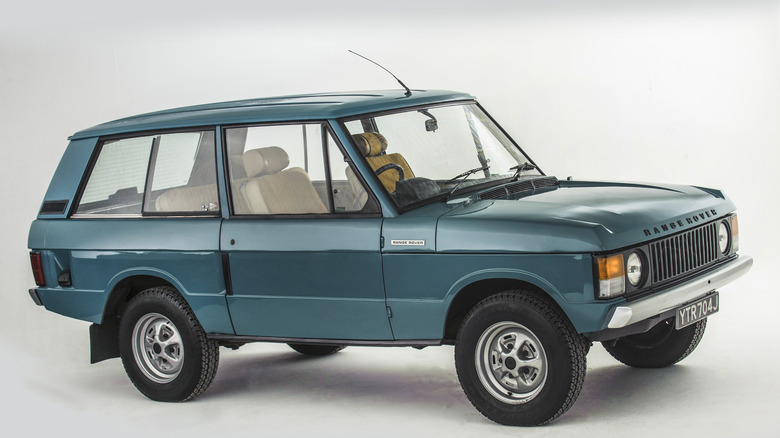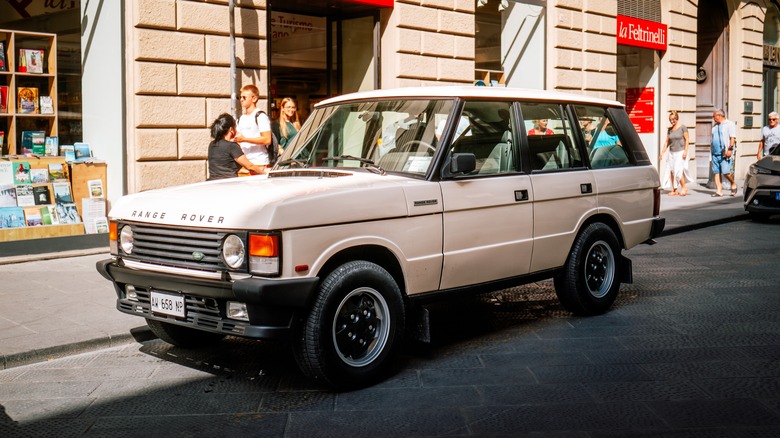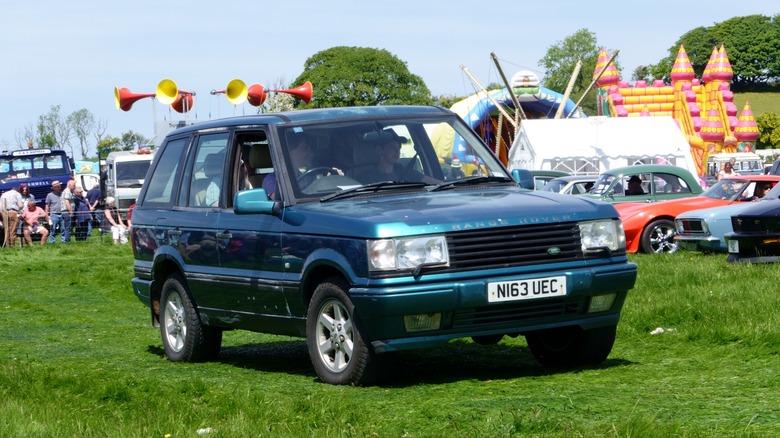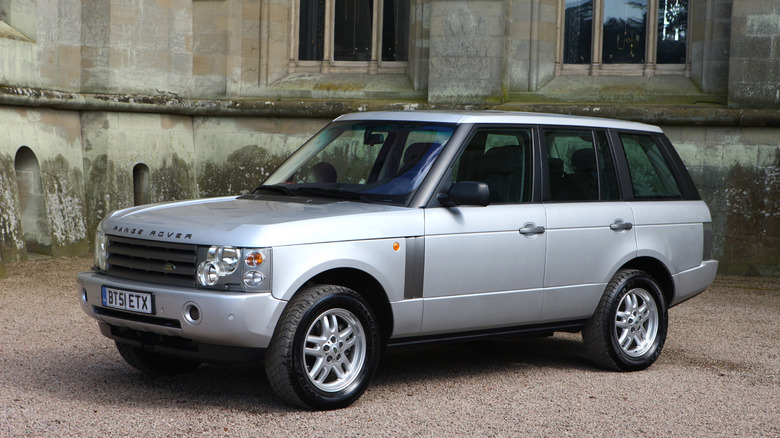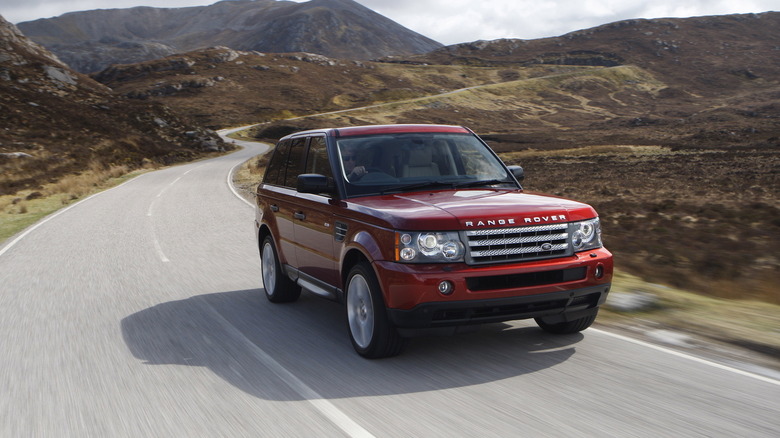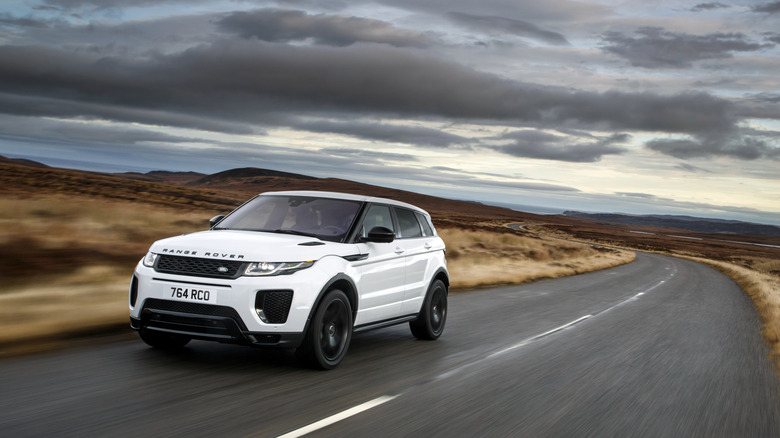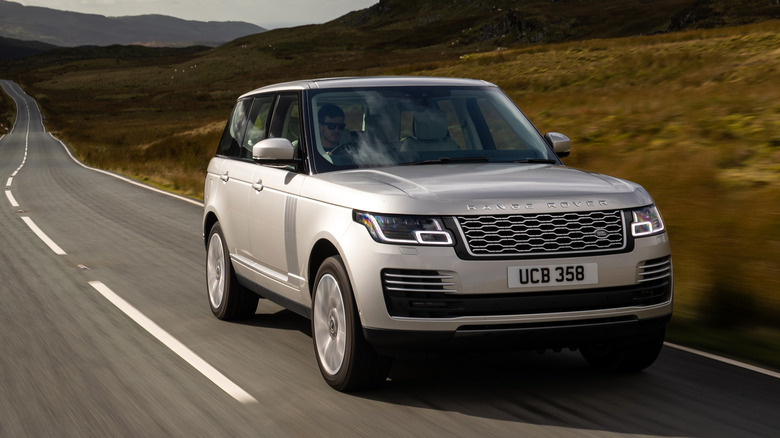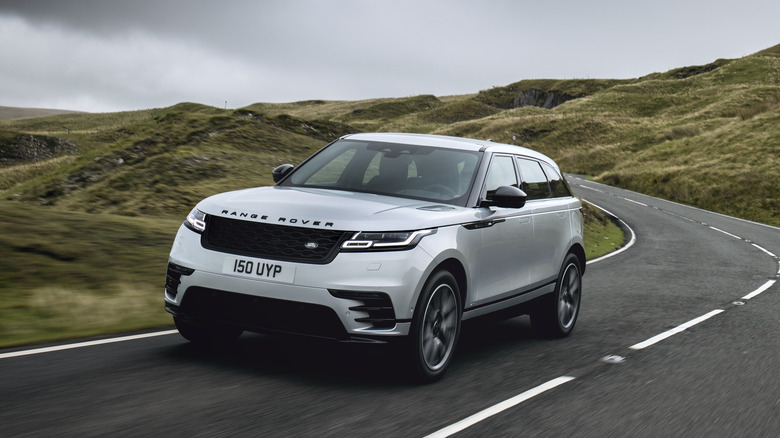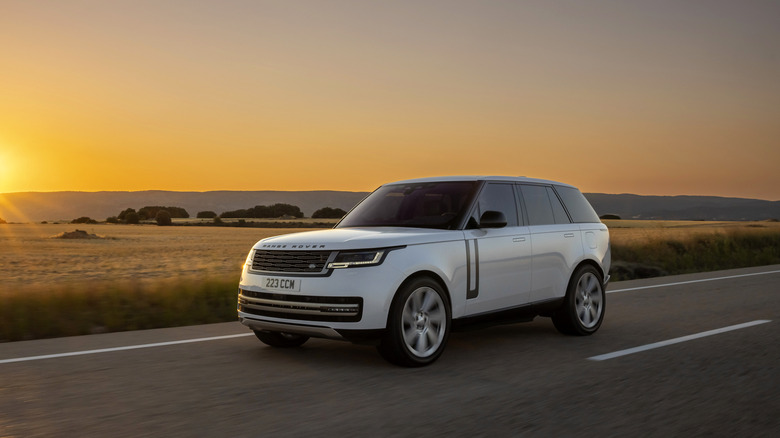The Rise Of Range Rover: The Story Behind The Ultimate Luxury Off-Roader
In 1947, visionary Maurice Wilks was walking on a Welsh beach when he stopped and, in the sand, sketched out a vehicle that could traverse any type of terrain without breaking a sweat. This vehicle would debut the very next year at the Amsterdam Motor Show, bearing a name we're all familiar with: Land Rover.
The original Series I Land Rovers were a success story of their own. As Richard Hammond explained on Drivetribe, a Land Rover was often the first vehicle that people in the more remote areas of the world had ever seen. While the Series I Land Rover is a legend in its own right, and there have been many fantastic Land Rovers over the years, the car it spawned a couple decades later is even more amazing.
What happens when you give a Land Rover an increased focus on on-road performance and, eventually, luxury? The Range Rover. Today, the Range Rover continues to carry the title of the ultimate luxury SUV with genuine off-road ability, and it's a high-end car that even most non-car enthusiasts immediately recognize. But how did the Range Rover get its start? How has it evolved over the past half-century-plus?
The beginning: Range Rover Classic
Debuting in 1970, the original Range Rover was created out of a need to plug a gap in Land Rover's lineup for a more road-focused and more comfortable, and most importantly, less utilitarian SUV. While the company didn't know it then, the Range Rover would kickstart the luxury SUV segment as we know it today.
The original continuously evolved across its 26-year production run, adding rear doors, more and more luxury features, a five-speed gearbox, antilock brakes, and even a long-wheelbase version. It was such a success, in fact, it continued to be produced alongside the replacement P38A Range Rover for two whole years, finally ending its successful run in 1996.
Power in the Range Rover Classic came from one of Britain's pride-and-joy engines: the Rover V8, one of the most reliable Land Rover engines ever made. Originally a Buick design, the all-aluminum small-block V8 was purchased by Rover in the '70s and it appeared in various British vehicles. In the Range Classic, it was a 3.5-liter with carburetors at first; then a 3.9-liter unit with fuel injection joined the lineup, along with a 4.2-liter unit, and eventually, diesel engines as well. Today, the original Range Rover is a beloved classic car, and it's one of the most popular donor cars for restomods, receiving anything from Chevy small block engines to full EV swaps.
Miscalculated and short-lived: P38A
Project 38 was the name given to the long-awaited replacement for the Range Rover Classic. Launched in 1994, it continued to be sold alongside the Classic for a couple of years, but this is the one that Land Rover wanted to get into the hands of owners. The styling, while familiar, was suitably updated for the '90s and the fast-approaching new millennium. However, peel away the new bodywork, and some things became painfully obvious.
The P38 (P for Pegasus, the name given to the design chosen for the production model) Range Rover was not mounted on an all-new platform. Instead, it was a heavily reworked version of the platform that underpinned the Classic. In other words, Land Rover was selling customers a brand-new SUV in 1994 with a platform that originated from the '70s. Not much was different under the hood, either, with either a Rover V8 or a BMW-sourced diesel engine.
BMW owned Land Rover during this time, and while it wasn't involved directly in the development of the P38, the board in Munich decided that the P38 Range Rover shouldn't stick around for very long. It didn't exactly impress journalists at the time, so the bosses put the development of the P38's replacement into high gear, with plans to launch it at the beginning of the new millennium. This time, Land Rover went all out.
The next level: L322
Debuting for model year 2003, the L322 Range Rover was such a huge step up that the P38 looks almost archaic in comparison. Gone was the body-on-frame construction that was already over 30 years old, and gone were the Rover V8s. In its place came a totally new chassis engineered by BMW and using a monocoque for the first time, as well as a whole lineup of new powertrains.
All of that was wrapped up in familiar, yet thoroughly modernized styling that is instantly recognizable today. There was even more work done under the hood, in the literal and figurative sense. In place of the Rover V8 came a variety of powertrains. The HSE V8, the sole model initially offered in North America, used a 4.4-liter V8 from BMW, but the later supercharged Range Rovers used Jaguar's supercharged 4.2-liter AJ V8.
There were also some diesels that were shared with PSA Group vehicles like the Peugeot 607 and Citroen C6. Permanent four-wheel drive was standard, along with air suspension and a locking center differential, not to mention a terrain-response system that Land Rover became known for.
Unlike the P38A, the L322 dominated the large luxury SUV segment, and it was also the generation that finally persuaded the global jet set to switch to the Range Rover, earning the car's luxury status for real. Despite its many, many, many reliability issues today, when it all works, the L322 deserves the utmost respect for revolutionizing luxury SUVs.
Expanding the family: Sport
With the Range Rover a runaway success, Land Rover decided to explore ways to expand the family and give more people with different tastes a slightly different Range Rover option. The first of those came along in 2005 with the original Range Rover Sport. On the face of it, the styling was very similar and in keeping with family tradition, but as the name implies, the Sport is designed to be the sportier, lighter, more performance-focused SUV.
Make no mistake, the Sport has way more off-road capability than any SUV that wears such a badge should be, but overall it was more focused for on-road use. To everyone's huge surprise, the Range Rover Sport went on to become a runaway success of its own, with the millionth Sport sold at the end of 2020.
Except, rather infamously, the original Range Rover Sport was kind of a fraud: Underneath all the Range Rover-inspired bodywork, there was almost nothing Range Rover. Land Rover based the Sport on the Land Rover Discovery/LR3.
Mercifully, both of the following generations were moved to the full-size Range Rover's underpinnings. The original Sport also shared most of the powertrains with its bigger brother, including the 2.7-liter diesel and Jaguar's supercharged V8.
A small big success: Evoque
Previewed by the intriguing diesel hybrid LRX concept from 2008, Land Rover expanded the Range Rover family again, and this time the brand was chasing mass appeal. The Range Rover Evoque, which debuted in 2012, is what you might call the baby Range Rover, a tiny crossover SUV that offered the styling, some of the capability, and some of the luxury, all of it wrapped up in a much smaller package at a much more appealing price tag. It worked. The Range Rover Evoque was, and you'll be very surprised to hear this, an absolute runaway success. Mostly.
The original launched with a three-door version, and that one didn't do very well. After Land Rover discontinued that, however, it was all smooth sailing for the Evoque. While early Evoques used Ford powertrains, later cars moved over to in-house-engineered Ingenium engines. Terrain response also came standard on the Evoque, and even though it didn't come with locking differentials or air suspension, it still had a good amount of that Land Rover capability.
The Evoque is still around, with the excellent second generation arriving in 2019. This Range Rover is much more luxurious on the inside, while the exterior styling is more evolutionary rather than revolutionary. The powertrain lineup remains mostly the same, except there's now also a three-cylinder plug-in hybrid version. Brave new world where a vehicle with a Range Rover badge has a three-pot under the hood.
Serious weight loss: L405
After a decade on the market, the L322 Range Rover was retired in 2011, with the all-new L405 making its debut in 2012. On the face of it, not much was different about it. The styling, while unmistakably new, still had most of the same traits, with some nicer lighting and new wheel designs. The three slats on the front doors, the big glass area — that was all still here, slightly revamped.
As usual, most of the changes came underneath the skin. Along with a new platform, the L405 Range Rover was now built atop an all-aluminum chassis. This meant, among other things, shaving nearly 1,000 pounds of the curb weight. While it wasn't a featherweight car, 1,000 pounds is a significant figure, and it worked wonders for just about every aspect of the driving experience.
The fourth-gen Rover also finally saw the reintroduction of the long-wheelbase version, as well as a multitude of new luxury features and equipment. Power came from both the Ingenium engines and the AJ V8 in some models, while the Supercharged version had upwards of 500 horsepower. The terrain-response system was revamped, now featuring an automatic mode that lets it deduce what sort of terrain you're traversing all by itself. The L405 Range Rover ended production in 2021, but its absolutely timeless design doesn't look a decade-plus old in any way.
Plugging the gap: Velar
The Sport had taken care of the gap in the Range Rover lineup for a sportier, even more road-focused SUV in the 2000s. By the 2010s, however, another hole sprung up in the Land Rover lineup. Following the success of the highly polarizing BMW X6, there was a need in Land Rover's lineup for a coupe SUV. To this day, Land Rover remains one of the few automakers to do this thing right with the fantastic Range Rover Velar.
Introduced in 2017, the Velar is a coupe SUV, but not in the way an X6 or a Mercedes GLE Coupe is. The Velar takes the regular Range Rover's styling, lowers it, and gives it a much sleeker sloping roofline, resulting in a hunkered-down, more squashed version of the regular Range Rover. Purely from a design perspective, the Velar is an absolute masterclass.
While it does have permanent four-wheel drive and terrain response, the Velar was not blessed with the Range Rover's architecture, instead using a version of the platform that underpins the Jaguar XE. Still, it's more capable than you might think. It's also chock full of luxury features, and the expansive powertrain lineup includes plug-in and mild hybrids, four-cylinders, six-cylinders, and in the case of the SVAutobiography, the wonderful supercharged V8 from Jaguar.
The latest and greatest: L460
Land Rover introduced the all-new fifth generation L460 in 2021 for model year 2022. The styling is, once again, an evolution of the previous one, but it has been moved firmly into the current decade with stuff like flush-fitted, electronically deployed door handles.
A major bit of news when the L460 debuted was its new MLA-Flex platform, which lets both internal-combustion and fully electric power units be fitted. Speaking of electrification, Land Rover took it a lot more seriously here, introducing two new plug-in hybrids with a class-leading EV range of up to 75 miles, while also hooking up the electric bits to a six-cylinder engine instead of a four-cylinder.
The full-size Range Rover, which SlashGear really enjoyed, is now available with seven seats for the first time, and naturally, you can also have a long wheelbase five-seater. The SV personalization and special-order program is still available for those prepared to pay a comical amount of money. The latest Range Rover and Range Rover Sport also channel their inner L322 as, in a twist of fate, they get BMW V8 power once again (with over 600 hp available), retiring the AJ V8 from the previous generation.
Despite all the changes that have happened to the latest Range Rover, it continues to be a titan in the world of luxury SUVs, and it's one of the few that can traverse land other SUVs get nightmares about.
